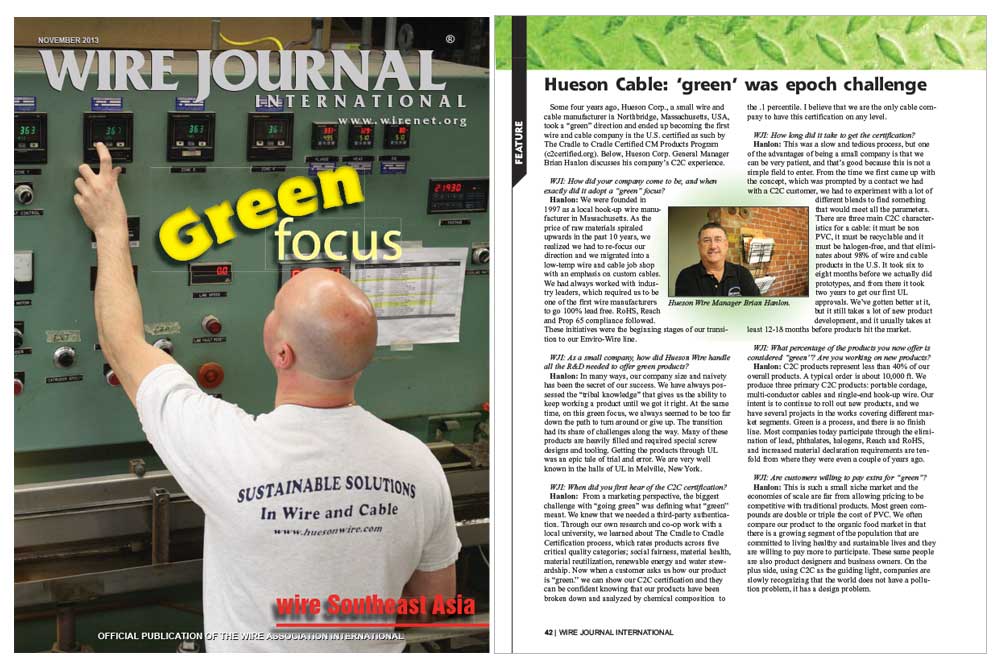NOVEMBER 2013 — Photos and accompanying article courtesy of Wire Journal International.
Hueson Cable: ‘green’ was epoch challenge
Some four years ago, Hueson Corp., a small wire and cable manufacturer in Northbridge, Massachusetts, USA, took a “green” direction and ended up becoming the first wire and cable company in the U.S. certified as such by The Cradle to Cradle Certified CM Products Program(c2certified.org). Below, Hueson Corp. General Manager Brian Hanlon discusses his company’s C2C experience.
WJI: How did your company come to be, and when exactly did it adopt a “green” focus?
Hanlon: We were founded in 1997 as a local hook-up wire manufacturer in Massachusetts. As the price of raw materials spiraled upwards in the past 10 years, we realized we had to re-focus our direction and we migrated into a low-temp wire and cable job shop with an emphasis on custom cables. We had always worked with industry leaders, which required us to be one of the first wire manufacturers to go 100% lead free. RoHS, Reach and Prop 65 compliance followed. These initiatives were the beginning stages of our transition to our Enviro-Wire line.
WJI: As a small company, how did Hueson Wire handle all the R&D needed to offer green products?
Hanlon: In many ways, our company size and naivety has been the secret of our success. We have always possessed the “tribal knowledge” that gives us the ability to keep working a product until we got it right. At the same time, on this green focus, we always seemed to be too far down the path to turn around or give up. The transition had its share of challenges along the way. Many of these products are heavily filled and required special screw designs and tooling. Getting the products through UL was an epic tale of trial and error. We are very well known in the halls of UL in Melville, New York.
WJI: When did you first hear of the C2C certification?
Hanlon: From a marketing perspective, the biggest challenge with “going green” was defining what “green” meant. We knew that we needed a third-party authentication. Through our own research and co-op work with a local university, we learned about The Cradle to Cradle Certification process, which rates products across five critical quality categories; social fairness, material health, material reutilization, renewable energy and water stewardship. Now when a customer asks us how our product is “green.” we can show our C2C certification and they can be confident knowing that our products have been broken down and analyzed by chemical composition to the .1 percentile. I believe that we are the only cable company to have this certification on any level.
WJI: How long did it take to get the certification?
Hanlon: This was a slow and tedious process, but one of the advantages of being a small company is that we can be very patient, and that’s good because this is not a simple field to enter. From the time we first came up with the concept, which was prompted by a contact we had with a C2C customer, we had to experiment with a lot of different blends to find something that would meet all the parameters. There are three main C2C characteristics for a cable: it must be non PVC, it must be recyclable and it must be halogen-free, and that eliminates about 98% of wire and cable products in the U.S. It took six to eight months before we actually did prototypes, and from there it took two years to get our first UL approvals. We’ve gotten better at it, but it still takes a lot of new product development, and it usually takes at least 12-18 months before products hit the market.
WJI: What percentage of the products you now offer is considered “green”? Are you working on new products?
Hanlon: C2C products represent less than 40% of our overall products. A typical order is about 10,000 ft. We produce three primary C2C products: portable cordage, multi-conductor cables and single-end hook-up wire. Our intent is to continue to roll out new products, and we have several projects in the works covering different market segments. Green is a process, and there is no finish line. Most companies today participate through the elimination of lead, phthalates, halogens, Reach and RoHS, and increased material declaration requirements are tenfold from where they were even a couple of years ago.
WJI: Are customers willing to pay extra for “green”?
Hanlon: This is such a small niche market and the economies of scale are far from allowing pricing to be competitive with traditional products. Most green compounds are double or triple the cost of PVC. We often compare our product to the organic food market in that there is a growing segment of the population that are committed to living healthy and sustainable lives and they are willing to pay more to participate. These same people are also product designers and business owners. On the plus side, using C2C as the guiding light, companies are slowly recognizing that the world does not have a pollution problem, it has a design problem.

